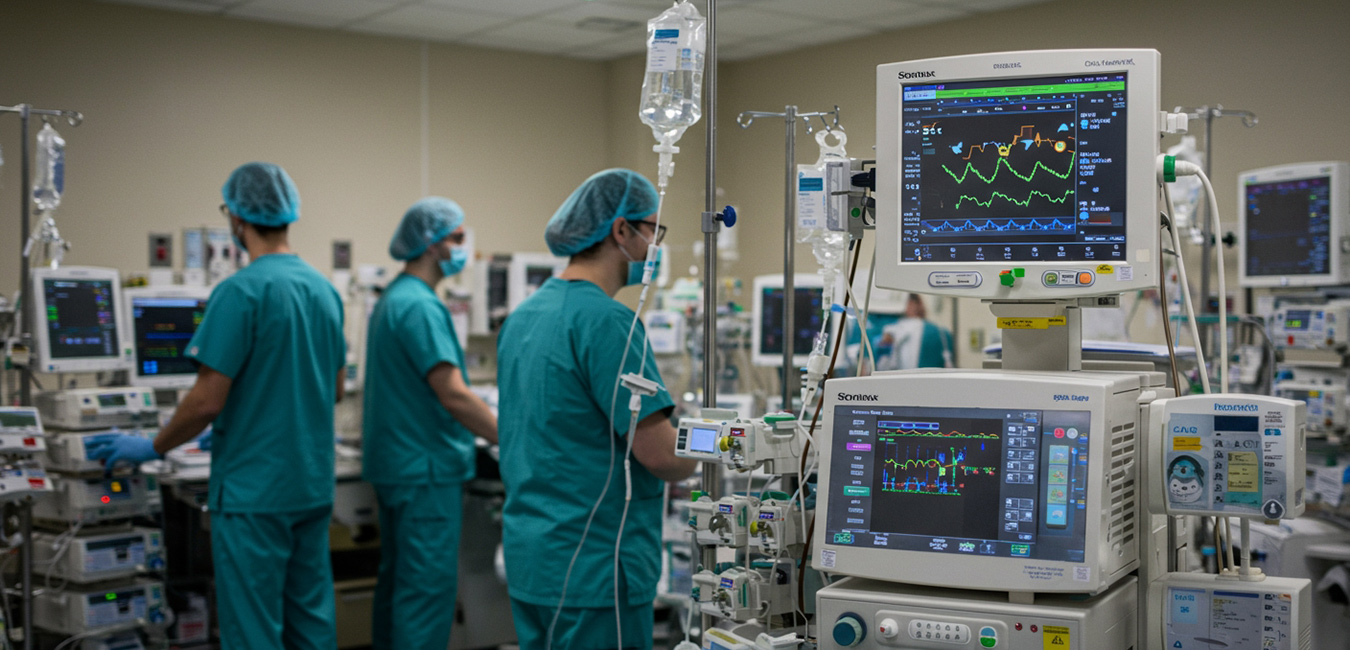
Continuous Renal Replacement Therapy (CRRT) is a critical therapeutic intervention designed for patients in the Intensive Care Unit (ICU) who suffer from acute kidney injury (AKI). Unlike traditional dialysis methods that involve periodic treatments, CRRT offers a continuous, 24-hour form of dialysis. This gradual approach allows for the removal of waste, fluids, and toxins from the blood, offering life-saving treatment for patients who are too unstable to undergo traditional dialysis, such as hemodialysis. CRRT is highly versatile and can be tailored to the patient’s specific needs by adjusting the treatment modality and flow rates.
How Does CRRT Work?
 CRRT uses a hemofilter to continuously filter the blood, closely mimicking the kidneys’ natural functions. Patients with acute kidney failure often have difficulty balancing fluid and electrolytes, which can lead to dangerous conditions such as fluid overload, hyperkalemia (high potassium), or acidosis. CRRT addresses these issues by steadily removing waste products, excess electrolytes, and fluids. It does this without the rapid fluctuations in blood pressure and fluid shifts commonly seen with traditional dialysis. These gradual processes help avoid additional stress on the patient’s cardiovascular system, a crucial factor for ICU patients with preexisting heart or respiratory issues.
CRRT uses a hemofilter to continuously filter the blood, closely mimicking the kidneys’ natural functions. Patients with acute kidney failure often have difficulty balancing fluid and electrolytes, which can lead to dangerous conditions such as fluid overload, hyperkalemia (high potassium), or acidosis. CRRT addresses these issues by steadily removing waste products, excess electrolytes, and fluids. It does this without the rapid fluctuations in blood pressure and fluid shifts commonly seen with traditional dialysis. These gradual processes help avoid additional stress on the patient’s cardiovascular system, a crucial factor for ICU patients with preexisting heart or respiratory issues.
The process begins when the patient’s blood is drawn through a catheter placed in a large vein, usually in the neck or groin. The blood is then passed through a filter where waste products, toxins, and excess fluid are removed before the cleansed blood is returned to the body. The filter can be adjusted to remove different levels of waste and fluid depending on the patient’s needs.
CRRT is delivered using specialized machines, such as the PrismaFlex system, which is a state-of-the-art device designed to handle the demands of critically ill patients. These machines allow for precise control over the flow rates and filtration settings, making CRRT both a flexible and effective tool in managing AKI.
Types of CRRT
There are several types of CRRT that can be used depending on the specific needs of the patient:
- Continuous Venovenous Hemofiltration (CVVH): This modality focuses on the removal of large amounts of fluid and waste using a filtration method. CVVH is particularly useful for patients suffering from fluid overload, as it removes water along with small- to medium-sized waste particles.
- Continuous Venovenous Hemodialysis (CVVHD): In this modality, a dialysis solution flows along one side of the filter, removing smaller waste molecules, such as urea and creatinine, while leaving behind important proteins and electrolytes.
- Continuous Venovenous Hemodiafiltration (CVVHDF): This approach combines both filtration and dialysis, allowing for the removal of waste products of various sizes along with the simultaneous control of fluid balance. It is often chosen for patients who require comprehensive waste removal and fluid management.
- Slow Continuous Ultrafiltration (SCUF): SCUF is primarily used for patients with severe fluid overload. This method focuses on removing excess fluid from the body without significantly affecting waste product levels
Each modality can be tailored to meet the patient’s needs, with varying levels of filtration and flow rates based on the severity of their condition. Our dialysis nurses monitor key parameters such as blood pressure, electrolytes, and fluid balance to adjust the treatment in real-time.
How Do You Know If You Need CRRT?
CRRT is most often used for critically ill patients who have a sudden loss of kidney function from various conditions, including sepsis, trauma, heart failure, or major surgery. These patients are typically in the ICU, where close monitoring is essential. Traditional dialysis methods, which involve high-volume fluid shifts over a short period, are often unsuitable for these patients, as they can cause rapid fluctuations in blood pressure, increasing the risk of complications.
The primary indications for CRRT include:
- Hemodynamic instability: Patients with low or fluctuating blood pressure, who are unable to tolerate the fluid shifts of traditional dialysis. CRRT’s continuous nature allows for gentle removal of fluids and waste products.
- Fluid overload: Patients with severe fluid retention, often caused by heart failure, liver disease, or other conditions can benefit from CRRT’s ability to gradually remove excess fluid without causing cardiovascular stress.
- Severe electrolyte imbalances: CRRT is particularly effective in managing dangerous levels of electrolytes, such as potassium, sodium, and calcium, which can lead to life-threatening conditions like hyperkalemia.
- Sepsis and multi-organ failure: In critically ill patients, sepsis can lead to acute kidney injury as the body’s organs shut down. CRRT provides vital renal support, allowing the kidneys time to recover while maintaining fluid and electrolyte balance.
Each modality can be tailored to meet the patient’s needs, with varying levels of filtration and flow rates based on the severity of their condition. Our dialysis nurses monitor key parameters such as blood pressure, electrolytes, and fluid balance to adjust the treatment in real-time.
Benefits of CRRT
CRRT offers several advantages over traditional dialysis, particularly for ICU patients with complex, multi-organ conditions:
- Better Tolerance in Critically Ill Patients: The slow, continuous nature of CRRT is ideal for patients who are hemodynamically unstable, as it reduces the risk of blood pressure drops and cardiovascular events.
- Precise Fluid Management: Because CRRT works continuously, it allows for meticulous control over fluid removal, which is especially important in managing conditions like acute respiratory distress syndrome (ARDS) or heart failure, where precise fluid balance is crucial.
- Reduced Risk of Complications: By avoiding the rapid shifts in blood pressure and fluid balance that occur with intermittent dialysis, CRRT minimizes the risk of complications such as cardiac arrest, arrhythmias, or increased intracranial pressure in patients with neurological injuries.
- Continuous Waste Removal: Unlike traditional dialysis, which only removes waste during scheduled sessions, CRRT provides ongoing filtration. This continuous removal of uremic toxins and electrolytes can help stabilize patients more quickly, leading to better outcomes.
- Compatibility with Other Therapies: CRRT can be used in conjunction with other extracorporeal treatments, such as the Molecular Adsorption Recirculating System (MARS), which is a specialized therapy for patients with liver failure. MARS combined with CRRT helps remove both kidney and liver toxins, offering comprehensive support for patients with multi-organ failure
Equipment Used in CRRT
In addition to the PrismaFlex system, which is widely recognized for its precision in delivering CRRT, several other devices are used to ensure the safe and effective administration of this therapy. For instance, portable water treatment systems like the AmeriWater Portable Reverse Osmosis (RO) System ensure that purified water is available for dialysis treatments, which is critical in preventing contamination and maintaining patient safety.
The BBraun Dialog and Fresenius hemodialysis machines are also commonly used in conjunction with CRRT, particularly in settings where intermittent hemodialysis may still be necessary as a follow-up to continuous therapy.
Challenges and Considerations
While CRRT offers numerous benefits, it is not without its challenges. One of the primary concerns is the intensive resource requirement, as CRRT is a labor and technology intensive process that requires continuous monitoring by trained medical staff. The need for specialized equipment and personnel can also increase costs, which may be a factor in resource-limited healthcare settings. However with Celly Mobile Dialysis, our nurses and equipment are mobile, meaning we can bring our skilled staff and state of the art equipment to our partnered facilities.
Another consideration is the risk of bleeding and infection, both of which are heightened due to the need for anticoagulation to prevent clotting in the dialysis circuit. Careful management of anticoagulation therapy is essential to minimize these risks.
Finally, while CRRT is a life-saving therapy for many critically ill patients, it is often used as a temporary measure. In some cases, patients may transition to intermittent dialysis or may eventually require kidney transplantation if their kidney function does not recover.
CRRT has become an indispensable tool in modern critical care, providing life-sustaining support to patients with acute kidney injury and other life-threatening conditions. Its continuous, gentle filtration process makes it ideal for managing fluid balance, electrolyte levels, and waste removal in the most vulnerable patients. The flexibility of CRRT, combined with its ability to be tailored to each patient’s specific needs, ensures that it will continue to be a vital part of renal replacement therapy in the ICU for years to come.